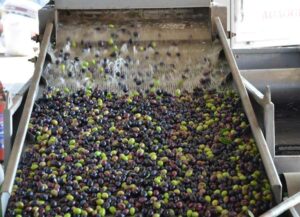Juan Sánchez Duarte & Fernando Diaz
Olive cake (Olea europea L.) is a co-product from olive oil extraction that can be composed of a mixture of skins, pulp, woody endocarps, and seeds. Depending on the oil extraction method applied, olive cake can be classified as following: 1) crude olive cake, which is the residue of the first oil extraction from whole olives by pressure; 2) exhausted olive cake, which results after oil extraction from the crude olive cake using solvents ̶ usually hexane; and 3) destoned olive cake, which results from the partial separation of the stone and pulp by screening or ventilation.
Olive cake can represent an environmental pollution problem since small amounts are used as fuel and requires a prolonged period for degradation. Nevertheless, considering its chemical composition (Table), olive cake can be used as ruminant feed.
| Nutrient (% DM) | Crude | Exhausted |
| DM (% of olive cake) | 91.6 | 88.9 |
| OM | 93.2 | 92.5 |
| Protein | 9.64 | 10.5 |
| NDF | 57.12 | 63.4 |
| ADF | 40.8 | 44.7 |
| Lignin | 20.1 | 22.1 |
| Fat | 10.5 | 1.88 |
| Sugars | 8.13 | 8.08 |
Chemical composition and nutritive value of olive cake is affected by multiple factors, among them, storage conditions and processing techniques.
A study carried out in Madrid evaluated the influence of storage time and processing on chemical composition and in vitro rumen fermentation of olive cake (Marcos et al., 2019). Samples of crude olive cake and exhausted olive cake (subjected to a second oil extraction) were compared during six months of storage.
Chemical composition
Increasing storage time of olive cake from 1 to 6 months resulted in increased fiber and lignin concentrations. However, sugar content decreased as storage time increased from 1 to 6 months. Storage time did not affect the olive cake protein concentration (Figure 1). Fat content was higher in crude olive cake than exhausted olive cake due to the second oil extraction.

Digestibility of DM and NDF decreased as storage time increased from 1 to 6 months (Figure 2). This effect was more pronounced in exhausted olive cake compared to crude olive cake. Decreases of DM and NDF digestibility were clearly associated to changes in the nutrient composition of olive cake, as storage changed from 1 to 6 months.

Gas production and DM effective degradability in crude and exhausted olive cake decreased as storage time increased from 1 to 6 months, which is in accordance with the changes observed in the olive cake chemical composition. Gas production was greater for exhausted than crude olive cake during the first 6 months of storage.
In vitro fermentation
Increasing storage time from 1 to 6 months linearly increased pH, but gas and total VFA production decreased. Similarly, acetate, propionate, and butyrate productions were linearly reduced with advancing storage time. These findings reflect the lower fermentability of fiber compared to sugars, which changed as storage time increased from 1 to 6 months. There was no effect of storage time on ammonia concentration.
In conclusion, the nutritive value of olive cake is reduced as storage time advances. This change affects negatively rumen degradability, which is mainly due to the loss of sugars and to the increase of fiber as storage time advances. Rumen degradability is greater in exhausted compared to crude olive cake during the first months of storage.
Reference
Marcos, C.N., de Evan, T., García‐Rebollar, P., de Blas, C., Carro, M.D. 2019. Influence of storage time and processing on chemical composition and in vitro ruminal fermentation of olive cake. Journal of animal physiology and animal nutrition. 103(5): 1303-1312.
© 2020 Dairy Knowledge Center. All Rights Reserved.









